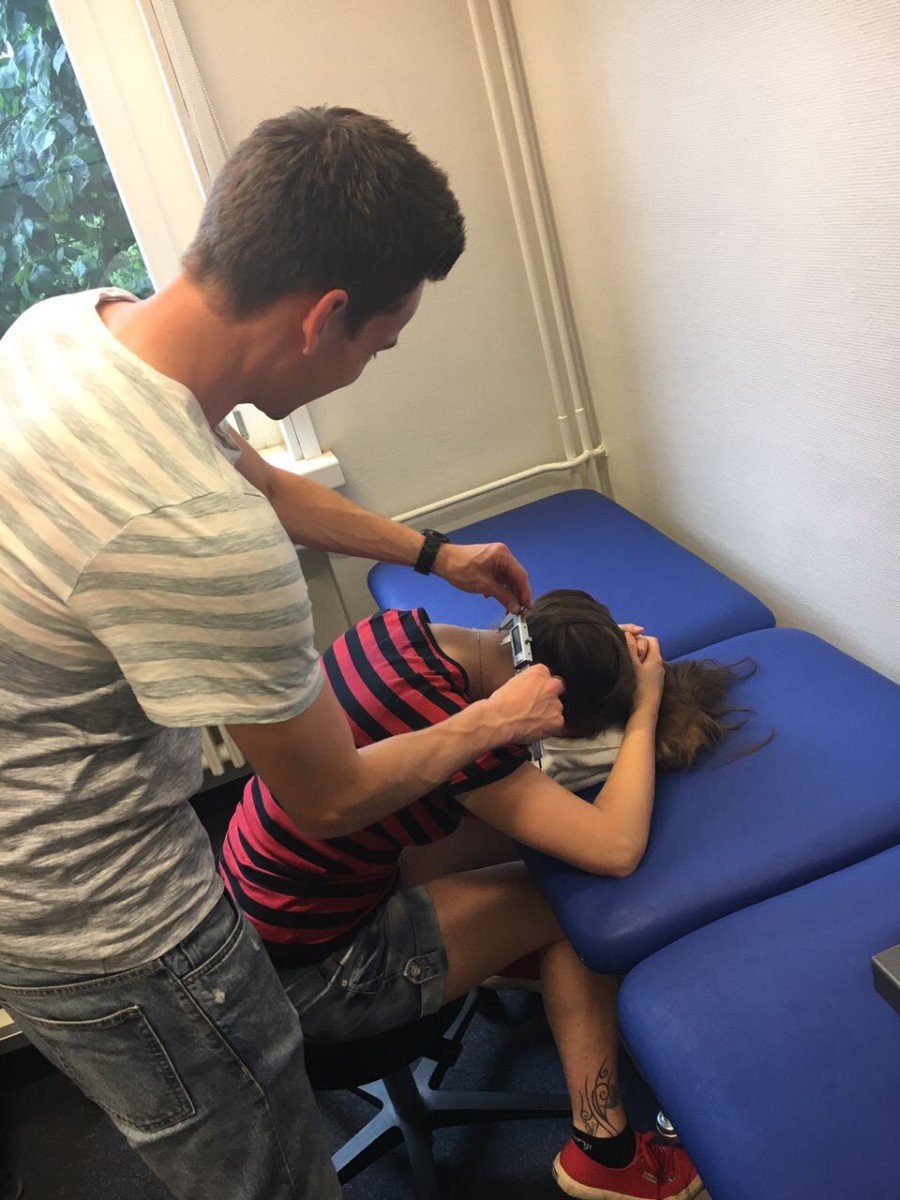New guest blog by Dr. Kerstin Lüdtke: Developing a two-point discrimination protocol for the cervical region to evaluate tactile acuity in patients with migraine
Thanks to the IMTA research foundation, who support our work on two-point discrimination in the upper cervical spine, we are now in the middle of the data collection for this exciting research!
The idea for this project was based on the quite robust evidence, that two-point discrimination as a marker for tactile acuity and potentially indicating the extent of cortical reorganisation is altered in chronic low back pain [1,2]. Surprisingly little evidence is available for chronic neck pain: only two studies were identified at the time of application for funding [8,11], an additional study was published recently [4]. All three studies showed that tactile acuity can be measured in the cervical area, however, the test procedure has not been used in the upper cervical spine and not been applied to patients suffering from headaches. Brain changes reported for migraine patients also include functional and structural alterations that are dominantly found in pain-related areas . Furthermore, results from studies applying quantitative sensory testing indicate that sensory alterations in the cervical region are common in patients with migraine [3,5,10], a finding very similar to changes observed in chronic low back pain [9]. It would therefore be a valuable additional information to identify whether migraine patients similar to chronic low back pain patients, show alterations in tactile acuity that can potentially be converted into an additional treatment module. But, before we can do all this we need to:
develop a test-protocol for the evaluation of 2-point-discrimination in the upper cervical region.
evaluate test-retest reliability (intra-rater reliability)
evaluate inter-rater reliability.
generate pilot data for a sample size calculation for a fully powered trial for
migraine patients vs healthy controls
migraine patients with neck dysfunctions compared to migraine patients without neck dysfunctions
We are using the following methods:
Following a thorough systematic review of the literature on published two-point discrimination procedures for the lumbar region and for the neck, an initial test protocol was developed and piloted in a small convenience sample of healthy participants (n=5). It showed to be feasible, easy to tolerate for participants and took very little time (approx 10 mins for each participant). Test-retest reliability was evaluated by examining the same participants (n=51) on the same day (same examiner). The brief version of the protocol is: a mechanical caliper (Figure 1) is placed at the level of C3 just lateral of the spinuous process with a distance of 5 cm, a distance at which every participant distinctly perceicves the two-points of the caliper tips. The distance is reduced by 1 mm until only 1 point can be perceived and increased again until two points are perceived. This is repeated 4 times (twice up and twice down), resulting in 4 values for a two-point treshold. The mean value of these 4 values is the TPD for this patient. The same procedure is repeated on each side of the neck.
The intrarater-reliability of the measurements was found to be good. (ICC 0,83 (SEM 0,31;SDD 0,85) for the left side of neck; ICC 0,818 (SEM 0,31;SDD 0,86) for the right side of neck.)
Figure 1: Caliper to measure two-point distance
The inter-rater reliability is evaluated by two examiners especially trained for the procedure detailed above. The same patient is examined twice: once by examiner A and once by examiner B with a 10 min break. For this purpose, 25 patients with migraine and 25 age- and gender-matched healthy participants were recruited. The data collection is ongoing and will be complemented by the evaluation of migraine patients with and without neck dysfunction. To avoid performance bias, both examiners are blinded towards the diagnosis of the participant. This is ensured by a third researcher, who contacts potential participants and instructs them to not reveal their status as a patient or a control person.
For the final part of the project, prior to the 2-point discrimination measurement, a third examiner will perform a physical examination of the cervical and thoracic region using the HATs identified by international consensus [7]. According to the findings from this examination, migraine patients will be labelled as „with neck dysfunction“ or „without neck dysfunction“. „Without neck dysfunction“ are only migraine patients who do not respond to any of the tests with symptoms referred to the head. Furthermore, patients must not show relevant side differences in any of the bilateral tests. Local pain is not regarded as a relevant finding.
Expected outcome
The hypothesis is, that migraine patients with neck dysfunctions will show a reduced tactile acuity compared to migraine patients without dysfunctions and that both migraine groups will have a reduced tactile acuity compared to healthy controls. We are further anticipating that the inter- and intra-rater reliability are acceptable to measure data in a fully powered trial with more than 1 examiner. If our findings are as expected, two-point discrimination could become a valuable examination technique for the evaluation of sensory discrimination in migraine patients. Sensory stimulation targetting cortical reorganisation could be a promising treatment technique in patients wth altered tactile acuity.
References
[1] Adamczyk W, Luedtke K, Saulicz E. Lumbar Tactile Acuity in Patients With Low Back Pain and Healthy Controls: Systematic Review and Meta-Analysis. Clin. J. Pain 2017.
[2] Catley MJ, O’Connell NE, Berryman C, Ayhan FF, Moseley GL. Is tactile acuity altered in people with chronic pain? a systematic review and meta-analysis. J. Pain Off. J. Am. Pain Soc. 2014;15.
[3] Cooke L, Eliasziw M, Becker WJ. Cutaneous allodynia in transformed migraine patients. Headache 2007;47:531–539.
[4] Harvie DS, Kelly J, Buckman H, Chan J, Sutherland G, Catley M, Novak J, Tuttle N, Sterling M. Tactile acuity testing at the neck: A comparison of methods. Musculoskelet. Sci. Pract. 2017;32:23–30.
[5] Kitaj MB, Klink M. Pain thresholds in daily transformed migraine versus episodic migraine headache patients. Headache 2005;45:992–998.
[6] Kroenke K, Spitzer RL, Williams JB. The PHQ-9: validity of a brief depression severity measure. J. Gen. Intern. Med. 2001;16:606–613.
[7] Luedtke K, Boissonnault W, Caspersen N, Castien R, Chaibi A, Falla D, Fernández-de-Las-Peñas C, Hall T, Hirsvang JR, Horre T, Hurley D, Jull G, Krøll LS, Madsen BK, Mallwitz J, Miller C, Schäfer B, Schöttker-Königer T, Starke W, von Piekartz H, Watson D, Westerhuis P, May A. International consensus on the most useful physical examination tests used by physiotherapists for patients with headache: A Delphi study. Man. Ther. 2016;23:17–24.
[8] Nolan MF. Quantitative measure of cutaneous sensation. Two-point discrimination values for the face and trunk. Phys. Ther. 1985;65:181–185.
[9] Puta C, Schulz B, Schoeler S, Magerl W, Gabriel B, Gabriel HHW, Miltner WHR, Weiss T. Somatosensory abnormalities for painful and innocuous stimuli at the back and at a site distinct from the region of pain in chronic back pain patients. PloS One 2013;8:e58885.
[10] Schwedt TJ, Zuniga L, Chong CD. Low heat pain thresholds in migraineurs between attacks. Cephalalgia Int. J. Headache 2015;35:593–599.
[11] Song ZK, Cohen MJ, Ament PA, Ho WH, Vulpe M, Schandler SL. Two-point discrimination thresholds in spinal cord injured patients with dysesthetic pain. Paraplegia 1993;31:425–493.
[12] Stewart WF, Lipton RB, Dowson AJ, Sawyer J. Development and testing of the Migraine Disability Assessment (MIDAS) Questionnaire to assess headache-related disability. Neurology 2001;56:S20-28.
[13] Vernon H, Mior S. The Neck Disability Index: a study of reliability and validity. J. Manipulative Physiol. Ther. 1991;14:409–415.






Comments